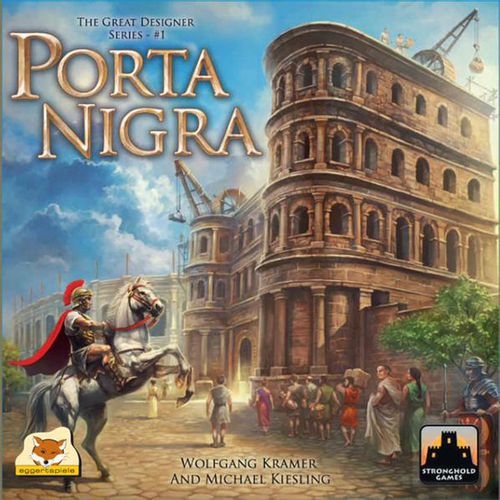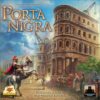- Learning time
- minutes
- First play time
- 120 minutes
Porta Nigra
Designed by: Michael Kiesling,Wolfgang Kramer
In Porta Nigra you are builders contributing to the construction of a Roman city: the Basilica, Amphitheatre, City Wall, and the Porta Nigra itself – the black gate.
Players each have a small deck of cards, on on every turn you have a hand of two to choose from. Each card has a certain number of actions on it, and you can choose 2 or 3 to activate. The actions consist of five things: buying bricks from one of the five brick shops (yellow, red, blue, black, white) using the bricks to build, raising money, or gathering torch or influence tokens – we’ll come to those in a bit.
Buying is straightforward – you pay the cost of the brick, and add it to your supply. Building is also fairly straightforward: add the brick or bricks (as a stack) to one of the four buildings in the corner of the board. Each has spaces to show what bricks they need and how many points you’ll score by building there. The catch with both buying and building, however, is that your Master Builder must be present: they move around the board clockwise between the four quarters, and moving from one quarter to another costs you money!
Building can also reward in other ways – there are always six building cards next to the board, and if you meet the requirements of that card (for instance, add two yellow bricks to the city wall) you take the card for yourself, and it will score you points at the end of the game. Influence tokens can be spent to buy influence cards – these are a mix of instant rewards such as bricks or a build action, or more end-game scoring to be totted up later.
Finally torches can be spent as an additional action on your turn, so these can be very useful.
After two rounds (in a three or four player game) or three rounds (in a two player game) final scores are tallied, with any building or influence cards scoring you additional points.
The guru's verdict
-
Take That!
Take That!
No stealing or sabotage, but players can still meddle by grabbing bricks or building buildings before someone else does. Turn order can sometimes be critical, which is why whoever's currently in last place chooses the first player at the start of a new round.
-
Fidget Factor!
Fidget Factor!
It's not a game drowning in rules, but how best to apply them can take some puzzling.
-
Brain Burn!
Brain Burn!
The heart of Porta Nigra is straightforward - buy bricks, use them to build - but how best to go about it is a different question. Moving your Master Builder costs you a coin each time you do it, and money can be scarce. But on the other hand, you can't spend the game sat in a single quarter!
-
Again Again!
Again Again!
There's a lot of variety here from how your own cards fall to the building and influence cards varying to what colour bricks are available.






Sam says
I usually like the games of these designers but although I can see the cleverness in Porta Nigra I found it too abstract to really feel immersed in the theme, and not interactive enough (like the even-more-abstract Mexica) to qualify as a fun puzzler. There is interaction in Porta Nigra, but it's kind of indirect, and the game as a whole felt a bit dry: literally travelling in circles building piles of bricks. If the buildings had taken on a shape of some kind that might have given a bit more focus, but you're simply moving a pile from one place to another, and I came away feeling a little underwhelmed.